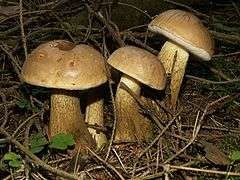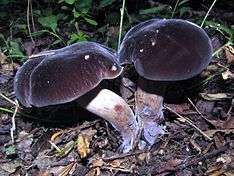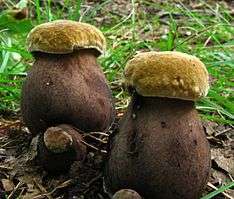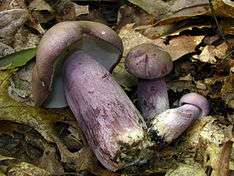Tylopilus
Tylopilus is a genus of over 100 species of mycorrhizal bolete fungi separated from Boletus. Its best known member is the bitter bolete (Tylopilus felleus), the only species found in Europe. More species are found in North America, such as the edible species T. alboater. Australia is another continent where many species are found. All members of the genus form mycorrhizal relationships with trees. Members of the genus are distinguished by their pinkish pore surfaces.
| Tylopilus | |
|---|---|
 | |
| Tylopilus felleus | |
| Scientific classification | |
| Kingdom: | |
| Division: | |
| Class: | |
| Order: | |
| Family: | |
| Genus: | Tylopilus P.Karst. (1881) |
| Type species | |
| Tylopilus felleus (Bull.) P.Karst. (1881) | |
| Synonyms[1] | |
Taxonomy
The genus was first defined by Petter Adolf Karsten in 1881.[6] The type species, Tylopilus felleus, was originally described in 1788 as a species of Boletus by French mycologist Pierre Bulliard.[7] Tylopilus means "bumpy or swollen pileus",[8] from the Greek tylos "bump" and pilos "hat".[9]
Molecular analysis indicates the genus, like other large genera within the Boletales, is polyphyletic.[10] A lineage of Tylopilus chromapes (now Harrya chromapes and related species) has been shown to be only distantly related to other members of Tylopilus. Hence T. chromapes is now the type species of the new genus Harrya and, related to it, several Australian species moved to Australopilus.[11] T. valens was also moved to its own genus, Pseudoaustroboletus.[12]
Description
Fruit bodies of the genus Tylopilus are encountered as large stout bolete mushrooms, which generally arise from the ground or occasionally from wood. They have stout stipes, which do not have a ring.[8] A key field character which distinguishes them from members of the genus Boletus is the presence of their pink-tinged pores (though these may be white when young).[13] The "pink pore" feature is a polyphyletic morphology that does not unite the Tylopilus species using traditional morphological characters (Smith and Thiers or Singer's concepts). The spore print manifests various shades of pinkish-brown, through reddish-brown and even chocolate brown.[8]
Edibility
Many species have a bitter taste and are inedible,[8] a key feature in identification.[13] The black velvet bolete (T. alboater) is edible and tasty, but often ignored.[8]
Species
As of August 2015, Index Fungorum lists 111 valid species of Tylopilus.[14] About 40 are found in western North America.[8] A large number have been recorded from Australia, with 26 aligned with existing taxa and another 15 not assignable. Members of the genus are also abundant in South America, particularly in forests with trees of the genus Dicymbe in Guyana, as well as Central America and elsewhere across tropical regions around the world.[15] All are mycorrhizal.
- Tylopilus acutesquamosus
- Tylopilus alboater
- Tylopilus albofarinaceus
- Tylopilus alkalixanthus
- Tylopilus alutaceoumbrinus
- Tylopilus ammiratii
- Tylopilus amylosporus
- Tylopilus appalachiensis
- Tylopilus arenarius
- Tylopilus argillaceus
- Tylopilus atratus
- Tylopilus atrobrunneus
- Tylopilus austrofelleus
- Tylopilus atronicotianus
- Tylopilus badiceps
- Tylopilus balloui (edible)[16]
- Tylopilus beelii
- Tylopilus brachypus
- Tylopilus brevisporus
- Tylopilus brunneirubens
- Tylopilus bulbosus
- Tylopilus brunneus
- Tylopilus castanoides[17]
- Tylopilus cellulosus
- Tylopilus chromoreticulatus
- Tylopilus corneri
- Tylopilus costaricensis
- Tylopilus cyanescens
- Tylopilus cyanogranulifer
- Tylopilus exiguus
- Tylopilus felleus
- Tylopilus ferrugineus
- Tylopilus fuligineoviolaceus[18]
- Tylopilus fumosipes
- Tylopilus funerarius
- Tylopilus gomezii
- Tylopilus griseocarneus
- Tylopilus guanacastensis
- Tylopilus hondurensis
- Tylopilus hongoi
- Tylopilus humilis
- Tylopilus indecisus
- Tylopilus intermedius
- Tylopilus isabellescens
- Tylopilus jalapensis
- Tylopilus javanicus
- Tylopilus leucomycelinus
- Tylopilus lividobrunneus
- Tylopilus louisii
- Tylopilus microsporus
- Tylopilus minor
- Tylopilus mitissimus
- Tylopilus montanus
- Tylopilus montoyae
- Tylopilus nanus
- Tylopilus nebulosus
- Tylopilus neofelleus
- Tylopilus nicaraguensis
- Tylopilus niger
- Tylopilus nigricans
- Tylopilus obscureviolaceus
- Tylopilus obscurus
- Tylopilus ochraceosquamosus
- Tylopilus oradivensis
- Tylopilus orsonianus
- Tylopilus otsuensis
- Tylopilus pachycephalus
- Tylopilus pakaraimensis
- Tylopilus peralbidus
- Tylopilus pernanus
- Tylopilus perplexus
- Tylopilus piniphilus
- Tylopilus pisciodorus
- Tylopilus plumbeoviolaceoides
- Tylopilus plumbeoviolaceus
- Tylopilus porphyrosporus
- Tylopilus potamogeton
- Tylopilus praeanisatus
- Tylopilus pseudoscaber
- Tylopilus punctatofumosus
- Tylopilus rhoadsiae
- Tylopilus rhodoconius
- Tylopilus rigens
- Tylopilus rubrobrunneus
- Tylopilus rufonigricans
- Tylopilus rugulosoreticulatus
- Tylopilus sanctae-rosae
- Tylopilus snellii
- Tylopilus sordidus
- Tylopilus striatulus
- Tylopilus subcellulosus
- Tylopilus subfusipes
- Tylopilus subniger
- Tylopilus subunicolor
- Tylopilus subvinaceipallidus
- Tylopilus sultanii
- Tylopilus suavissimus
- Tylopilus subcellulosus
- Tylopilus tabacinus
- Tylopilus temucensis
- Tylopilus tenuis
- Tylopilus variobrunneus
- Tylopilus veluticeps
- Tylopilus vinaceipallidus
- Tylopilus vinaceogriseus
- Tylopilus vinosobrunneus
- Tylopilus violaceus
- Tylopilus violatinctus
- Tylopilus virens
- Tylopilus viscidichromapes
- Tylopilus williamsii
- Tylopilus zambianus
References
- "Tylopilus P. Karst. 1881". MycoBank. International Mycological Association. Retrieved 30 August 2011.
- Murrill WA (1909). "The Boletaceae of North America – 1". Mycologia. 1 (1): 4–18 (see p. 15). doi:10.2307/3753167.
- Bataille F. (1908). "Quelques champignons intéressants des environs de Besançon" [Rare mushrooms in the vicinity of Besançon]. Bulletin de la Société d'Histoire Naturelle du Doubs (in French). 15: 23–61.
- Beck G. (1923). "Versuch einer systematischen Gliederung der Gattung Boletus L. em". Zeitschrift für Pilzkunde (in German). 2 (7): 141–49.
- Snell WH (1942). "New proposals relating to the genera of the Boletaceae". Mycologia. 34 (4): 403–11. doi:10.2307/3754982.
- Karsten PA (1881). "Enumeratio Boletinearum et Polyporearum Fennicarum, systemate novo dispositarum". Revue mycologique, Toulouse. 3 (9): 16–19.
- Bulliard JBF (1788). Herbier de la France (in French). 8. Paris: Chez l'auteur, Didot, Debure, Belin. plate 379.
- Bessette AR, Bessette A, Roody WC (2000). North American Boletes: A Color Guide to the Fleshy Pored Mushrooms. Syracuse, New York: Syracuse University Press. p. 256. ISBN 0-8156-0588-9.
- Nilson S, Persson O (1977). Fungi of Northern Europe 1: Larger Fungi (Excluding Gill-Fungi). Harmondsworth, England: Penguin. pp. 102–03. ISBN 0-14-063005-8.
- Binder M, Hibbett DS (2006). "Molecular systematics and biological diversification of Boletales" (PDF). Mycologia. 98 (6): 971–81. doi:10.3852/mycologia.98.6.971. Archived from the original (PDF) on 26 December 2011.
- Halling RE, Nuhn M, Osmundson T, Fechner N, Trappe JM, Soytong K, Arora D, Hibbett DS, Binder M (2012). "Affinities of the Boletus chromapes group to Royoungia and the description of two new genera, Harrya and Australopilus". Australian Systematic Botany. 25: 418–31. doi:10.1071/SB12028.
- Li Y-C, Li F, Zeng N-K, Cui Y-Y, Yang ZL (2014). "A new genus Pseudoaustroboletus (Boletaceae, Boletales) from Asia as inferred from molecular and morphological data". Mycological Progress. 13. doi:10.1007/s11557-014-1011-1. 1011.
- Kuo, Michael (March 2005). "The genus Tylopilus". Retrieved 23 August 2011.
- Kirk PM. "Species Fungorum (version 26th August 2015). In: Species 2000 & ITIS Catalogue of Life". Retrieved 29 August 2015.
- Watling R. (2001). "Australian Boletes: Their Diversity and Possible Origins". Australian Systematic Botany. 14 (3): 407–16. doi:10.1071/SB99031.
- Phillips, Roger (2010). Mushrooms and Other Fungi of North America. Buffalo, NY: Firefly Books. p. 284. ISBN 978-1-55407-651-2.
- Takahashi H. (2002). "Two new species and one new combination of Agaricales from Japan". Mycoscience. 43 (5): 397–403. doi:10.1007/s102670200058.
- Takahashi H. (2007). "Five new species of the Boletaceae from Japan". Mycoscience. 48 (2): 90–9. doi:10.1007/s10267-006-0332-6p.
External links


- Mushroom Expert - The Genus Tylopilus
- "Tylopilus P.Karst". Atlas of Living Australia.



